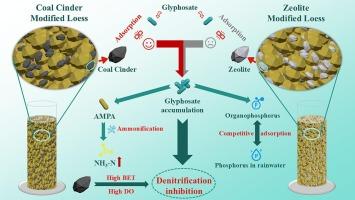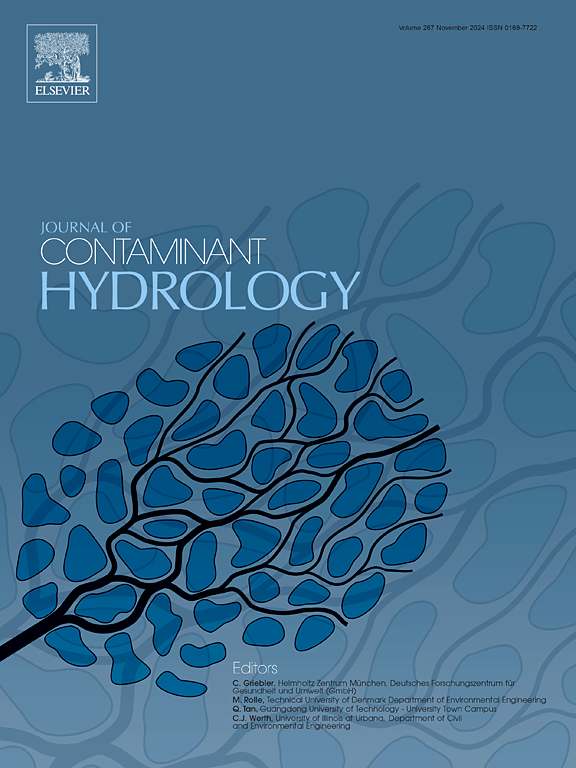Nutrient removal characteristics of the bioretention cell under high concentration glyphosate stress
IF 4.4
3区 环境科学与生态学
Q2 ENVIRONMENTAL SCIENCES
引用次数: 0
Abstract
The pesticide glyphosate is widely used in agriculture and is frequently detected in the natural environment. However, the effect of glyphosate in stormwater runoff on the nutrient removal efficiency of bioretention cells remains unclear. Coal- and zeolite-modified bioretention cells were constructed in this study, and their ammonia‑nitrogen (NH4+-N) removal efficiency was inhibited at the beginning of glyphosate stress. In the late stage of the stress test, the NH4+-N removal efficiency gradually recovered to >90 %, the concentration of nitrate nitrogen (NO3−-N) was stable at 10–15 mg/L, and the concentration of nitrite‑nitrogen (NO2−-N) was stable at 0.05–1.81 mg/L. Glyphosate negatively impacted nitrogen removal performance. The total nitrogen (TN) concentration also increased, and its removal efficiency decreased to <10 %. Total phosphorus (TP) concentrations during the initial rainfall event were significantly correlated with glyphosate concentrations (p < 0.01), with effluent TP reaching a maximum of 121 mg/L. In the late stage of the stress test, the phosphorus removal capacity of the bioretention cell gradually recovered. The relative abundance of glyphosate-tolerant bacteria and dominant decomposition bacteria increased, while the abundance of some denitrifying functional bacteria decreased under stress, ultimately affecting the water purification effect of the bioretention cell. In summary, glyphosate stress reduced the nitrogen and phosphorus removal in the bioretention cell; the phosphorus removal capacity gradually recovered, but nitrogen removal remained inhibited.

高浓度草甘膦胁迫下生物滞留细胞的营养物去除特性
农药草甘膦在农业中应用广泛,在自然环境中也经常被检测到。然而,雨水径流中草甘膦对生物保留细胞去除养分效率的影响尚不清楚。本研究构建了煤和沸石改性的生物滞留细胞,其氨氮(NH4+- n)的去除效率在草甘膦胁迫开始时受到抑制。在应力试验后期,NH4+-N去除率逐渐恢复到90%,硝态氮(NO3−-N)浓度稳定在10 ~ 15 mg/L,亚硝酸盐氮(NO2−-N)浓度稳定在0.05 ~ 1.81 mg/L。草甘膦对脱氮性能有负面影响。总氮(TN)浓度升高,去除率降至10%。降雨初期总磷(TP)浓度与草甘膦浓度呈极显著相关(p < 0.01),出水TP最高可达121 mg/L。在应力试验后期,生物滞留细胞的除磷能力逐渐恢复。在胁迫下,草甘膦耐受菌和优势分解菌的相对丰度增加,而部分反硝化功能菌的丰度下降,最终影响了生物保留细胞的净水效果。综上所述,草甘膦胁迫降低了生物滞留细胞的氮磷去除率;磷的去除能力逐渐恢复,但氮的去除能力仍然受到抑制。
本文章由计算机程序翻译,如有差异,请以英文原文为准。
求助全文
约1分钟内获得全文
求助全文
来源期刊

Journal of contaminant hydrology
环境科学-地球科学综合
CiteScore
6.80
自引率
2.80%
发文量
129
审稿时长
68 days
期刊介绍:
The Journal of Contaminant Hydrology is an international journal publishing scientific articles pertaining to the contamination of subsurface water resources. Emphasis is placed on investigations of the physical, chemical, and biological processes influencing the behavior and fate of organic and inorganic contaminants in the unsaturated (vadose) and saturated (groundwater) zones, as well as at groundwater-surface water interfaces. The ecological impacts of contaminants transported both from and to aquifers are of interest. Articles on contamination of surface water only, without a link to groundwater, are out of the scope. Broad latitude is allowed in identifying contaminants of interest, and include legacy and emerging pollutants, nutrients, nanoparticles, pathogenic microorganisms (e.g., bacteria, viruses, protozoa), microplastics, and various constituents associated with energy production (e.g., methane, carbon dioxide, hydrogen sulfide).
The journal''s scope embraces a wide range of topics including: experimental investigations of contaminant sorption, diffusion, transformation, volatilization and transport in the surface and subsurface; characterization of soil and aquifer properties only as they influence contaminant behavior; development and testing of mathematical models of contaminant behaviour; innovative techniques for restoration of contaminated sites; development of new tools or techniques for monitoring the extent of soil and groundwater contamination; transformation of contaminants in the hyporheic zone; effects of contaminants traversing the hyporheic zone on surface water and groundwater ecosystems; subsurface carbon sequestration and/or turnover; and migration of fluids associated with energy production into groundwater.
 求助内容:
求助内容: 应助结果提醒方式:
应助结果提醒方式:


